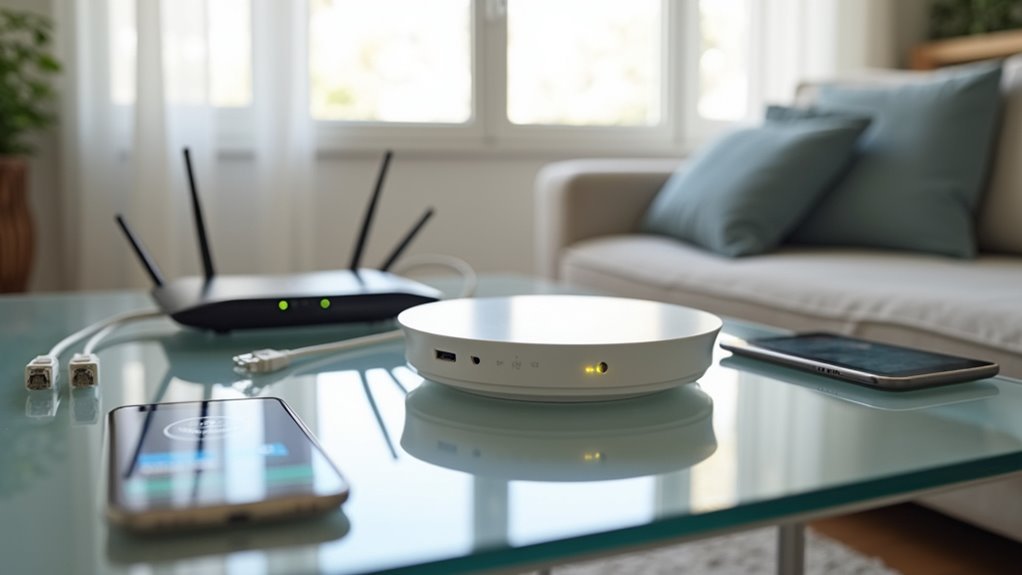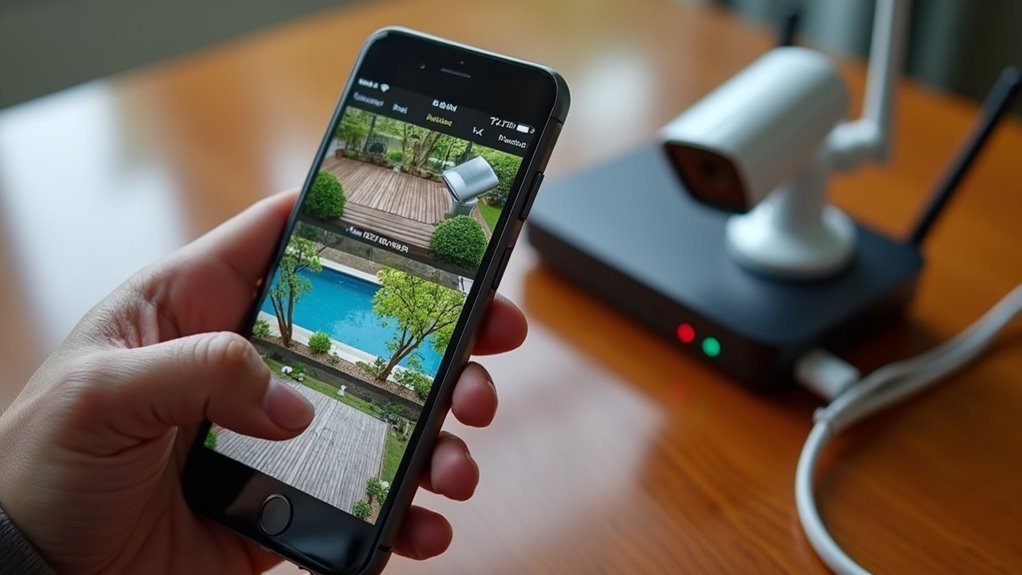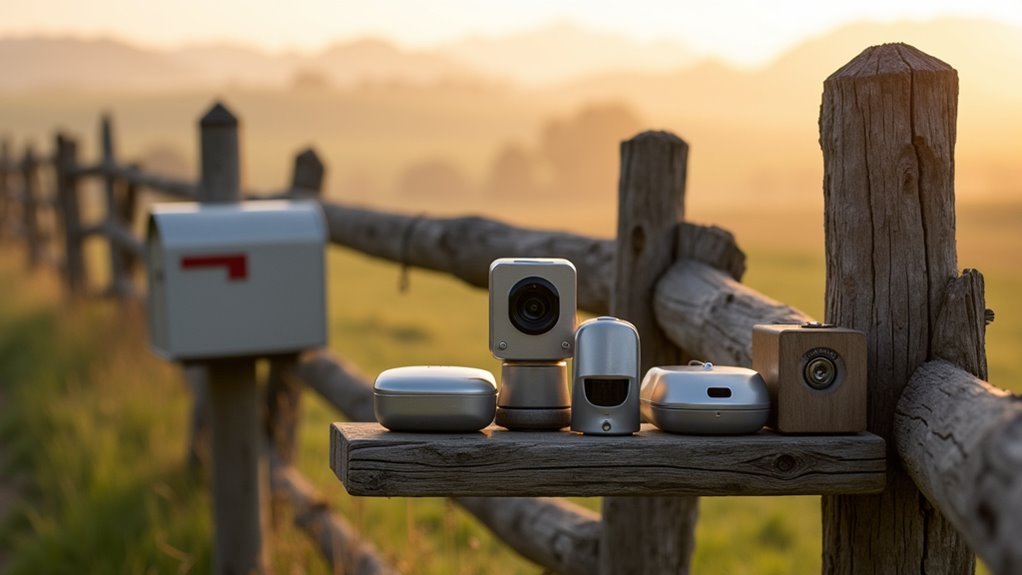Your smart home setup promised convenience, but now you’re dealing with unresponsive devices, failed automations, and connectivity issues that seem to multiply by the day. Whether it’s your Apple TV losing connection or your HomePod mini refusing to control accessories, home hub problems can transform your tech sanctuary into a source of daily frustration. The good news? Most of these issues stem from a handful of common culprits that you can identify and fix yourself.
Check Your Network Connection and Router Settings

First, you’ll want to guarantee your home hub device is powered on and properly connected to your Wi-Fi network. This basic step guarantees your Apple TV or HomePod can function correctly as your smart home’s central command.
Next, restart your router to reset network connections and resolve connectivity issues. This simple action often fixes device recognition problems that plague home hubs.
Check your router settings to confirm both 2.4GHz and 5GHz bands are available. If devices struggle with auto-switching between bands, consider separating them into individual networks with distinct names. This improves connectivity for HomePods and other smart devices.
Finally, verify your hub’s positioned within reasonable distance from the router. Ideal signal strength prevents connectivity issues and guarantees reliable performance.
Update Software on All Hub Devices
Once you’ve confirmed your network connection is stable, you’ll need to update software on all hub devices. Keeping your Apple TV HD, Apple TV 4K, and HomePod mini updated is essential for maintaining connectivity within your HomeKit ecosystem.
Navigate to settings on each device while they’re connected to Wi-Fi and powered on. Check for firmware updates that address bugs and security vulnerabilities, enhancing overall performance.
Regular firmware updates are crucial for maintaining optimal device performance and protecting against security vulnerabilities in your smart home network.
Don’t forget to verify iOS updates on your iPhone or iPad, as outdated mobile devices can hinder communication with your Apple home setup.
Access the Home app to monitor device status. If connectivity issues persist after updating, restart all devices to refresh their connections and settings, which often resolves lingering problems.
Restart Your Home Hub and Connected Accessories

When your hub devices still aren’t responding properly after software updates, restarting them often clears up stubborn connectivity issues. Power cycle your home hub by unplugging it from the power source, waiting about 10 seconds, then plugging it back in. This resets the Wi-Fi and HomeKit connections.
| Hub Type | Restart Method | Wait Time |
|---|---|---|
| Apple TV | Unplug power cord | 10 seconds |
| HomePod mini | Unplug power cable | 10 seconds |
| Other hubs | Remove power source | 10 seconds |
Next, restart connected accessories by removing batteries or unplugging them. Reboot your iPhone or iPad afterward to refresh their HomeKit connections. If problems persist, consider factory resetting your home hub to resolve deeper connectivity issues.
Verify Icloud and Apple ID Settings
Why do HomeKit devices sometimes fail to communicate with your home hub even after restarts? The culprit might be your iCloud and Apple ID configuration. Your Home app relies heavily on proper authentication and synchronization across devices.
Start by verifying you’re using the same Apple ID for both iCloud and the Home app on all devices. Mismatched accounts create connectivity barriers that prevent seamless communication.
Essential steps to resolve these issues:
- Enable iCloud Keychain in your settings for enhanced security and cross-device integration
- Activate two-factor authentication on your Apple ID, which HomeKit requires for functionality
- Confirm the primary Home user has proper permissions to manage devices and settings
Finally, review your iCloud settings to verify all HomeKit-related features are enabled for peak hub performance.
Disable and Re-enable Hub Functionality

Even with correct iCloud settings, your home hub may require a more direct reset approach.
Sometimes troubleshooting iCloud configurations isn’t enough—your home hub device may need a hands-on restart to restore proper functionality.
Navigate to the Home app and select your Apple TV or HomePods to disable the hub option, then re-enable it to refresh the connection. Before disabling, verify your home hub isn’t currently managing any automations, as this may cause unpredictable behavior when re-enabling.
After re-enabling hub functionality, verify it shows “Connected” status rather than “Standby” in the Home app to confirm proper operation.
Consider rebooting the hub device after re-enabling to verify all settings are properly applied and the device operates effectively.
If problems persist, performing a factory reset on the hub device can clear potential software glitches affecting performance.
Reset Network Settings on Your Devices
If your home hub continues experiencing connectivity problems after re-enabling its functionality, resetting network settings on your iOS devices can eliminate corrupted network configurations that interfere with proper communication.
This troubleshooting step proves especially effective when your HomePod mini appears in “standby” mode and won’t connect to your smart devices.
Navigate to Settings > General > Transfer or Reset iPhone/iPad > Reset > Reset Network Settings. This action clears all saved Wi-Fi networks, Bluetooth connections, and VPN configurations, forcing your device to establish fresh connections.
- You’ll need to re-enter all Wi-Fi passwords after the reset
- The process affects Bluetooth and VPN settings alongside Wi-Fi networks
- Fresh network connections often resolve persistent home hub communication issues
Remove and Re-add Problematic Accessories
When certain accessories remain unresponsive despite network troubleshooting, removing and re-adding them to your Home app can restore proper functionality by clearing corrupted connection data.
Open the Home app, select the problematic accessory, and remove it from your home setup to reset its connection.
Before re-adding, verify the accessory is powered on and positioned within range of your HomeKit hub.
Follow the manufacturer’s specific setup instructions when adding it back to prevent configuration errors.
If the accessory still won’t connect, check the manufacturer’s app for firmware updates and perform a factory reset if needed.
Once you’ve successfully re-added the device, monitor its responsiveness in the Home app to verify stable connectivity and identify any recurring issues.
Configure Proper Device Positioning and Range
While troubleshooting connectivity issues, you’ll often find that poor device positioning creates the root cause of Home Hub problems. Your HomePod mini’s placement directly impacts its ability to communicate effectively with smart accessories throughout your home.
Strategic positioning guarantees peak performance:
- Central placement at elevated locations – Position your HomePod mini on a shelf in your home’s center to maximize Wi-Fi coverage and minimize dead zones.
- Maintain distance from interference sources – Keep at least 3-5 feet away from microwaves, cordless phones, and other electronic devices that disrupt signals.
- Consider mesh networks for larger homes – Extend coverage to guarantee your hub maintains strong connectivity across expansive spaces.
Regularly assess the distance between your HomePod mini and connected devices, as limited communication range often causes persistent connectivity problems.
Review and Adjust Automation Rules
Beyond physical placement considerations, automation conflicts frequently undermine your Home Hub’s stability and performance. Review each automation rule in your HomeKit app to verify they’re properly configured and not creating conflicts.
Test individual automations to pinpoint specific triggers causing connectivity issues. Look for outdated or incompatible devices within automations that could hinder responsiveness.
Isolate each automation individually to identify problematic triggers and remove outdated devices that compromise your smart home’s performance.
Adjust timing and conditions to better match your daily routines and device capabilities. If multiple automations trigger simultaneously, they’ll compete for resources and cause malfunctions.
Disable unused automations to simplify your setup and eliminate potential error sources. This streamlined approach reduces processing overhead on your Home Hub.
Properly managed automation rules prevent system overload while maintaining the smart home functionality you need.
Perform a Factory Reset as Last Resort
If you’ve exhausted all other troubleshooting methods and your HomePod or Apple TV still won’t function properly as a home hub, it’s time to contemplate a factory reset.
You’ll want to use this nuclear option only when persistent connectivity issues remain unresolved, since you’ll lose all your custom settings and configurations.
Before you proceed, understand the specific reset steps for your device and prepare to reconfigure everything from scratch.
When to Reset
Factory resets represent the nuclear option in your troubleshooting arsenal—powerful but destructive.
You should only consider this drastic measure after you’ve exhausted every other solution. Your HomePod mini, like other smart home devices, can benefit from a fresh start when persistent issues won’t resolve through conventional methods.
Before proceeding, document your current settings and configurations to recreate them later.
Remember that you’ll lose all personalized data and need to reconfigure everything from scratch.
Consider a factory reset when you’re experiencing:
- Chronic connectivity issues that persist despite multiple reboots and network troubleshooting
- Severe performance degradation that considerably impacts daily functionality
- Corrupted settings that prevent normal operation
Follow your manufacturer’s specific reset instructions carefully to guarantee safe completion.
Reset Process Steps
When you’ve decided a factory reset is necessary, the process varies depending on your specific home hub device. For HomePod and HomePod mini, unplug the device first, then press and hold the top until you see the spinning white light turn red. Wait for three beeps to confirm completion. Apple TV users should navigate to Settings > System > Reset and select the option to erase all settings.
| Step | HomePod/HomePod mini | Apple TV |
|---|---|---|
| 1 | Unplug device | Open Settings |
| 2 | Press and hold top | Navigate to System |
| 3 | Wait for red light | Select Reset |
| 4 | Listen for three beeps | Choose erase all settings |
| 5 | Reconfigure in Home app | Reconfigure in Home app |
After completion, you’ll need to reconfigure your hub in the Home app using your Wi-Fi network.
Frequently Asked Questions
Why Is My Homepod Home Hub Not Working?
Your HomePod home hub isn’t working likely due to Wi-Fi connectivity issues, outdated software, or router setting changes. Check your internet connection, update the firmware, and verify it’s properly configured in your Home app.
What Is My Home Hub on My Iphone?
Your home hub on your iPhone is either an Apple TV or HomePod that’s designated to control HomeKit devices remotely. Check it by opening the Home app, tapping Home, then viewing “Home Hubs & Bridges.”
Why Can’t I Use My Ipad as a Home Hub Anymore?
Your iPad can’t function as a home hub if it’s running outdated iOS, isn’t signed into iCloud, lacks Wi-Fi connection, has incorrect permissions, or was recently reset.
How Do I Reset My Apple Home Hub?
You’ll reset your Apple Home Hub by opening the Home app, selecting your hub device, and removing it from settings. For HomePods, unplug for ten seconds, then hold the top button.





Leave a Reply